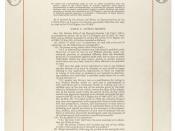Sexual Orientation and the Protected Class
Members of the five Protected Classes in America are afforded certain rights and privileges that, in theory, all of us are "guaranteed" by the U.S. Constitution. People of all races, all colors, each gender, every religion, and most ethnic groups are afforded these rights. These rights are stated and clarified in both laws and precedents, which create some basic employment practices. Yet, over time, we ask questions as to who should be a protected class. Our question for this work is to present an argument regarding whether sexual affinity should be a protected class in America. .
There are a multitude of factors to consider when addressing whether affinity should be ruled as a separate class. For the scope of this work, we address four relevant topics. One of the first questions that arises in considering whether affinity as a protected class is whether sexual affinity is genetically predetermined or if it is a choice.
The argument has been made that affinity orientation is not a choice but is the result of genetics. If this is a true statement, proponents contend, then a person has no more control over their sexual orientation then they do their gender or race. Supporters suggesting that affinity is genetic extend the argument to a conclusion that affinity orientation should be protected under Title VII of the Civil Rights Act of 1964, as amended.
Much research has been done to test this theory. One major study was done using identical twins as subjects by Bailey at the University of Queensland in Australia. Using a statistically significant sample of over 14,000 sets of twins, Bailey and his associates found that only 38% of homosexual subjects had a twin with the same affinity. For females, the percentage was approximately 30%.


